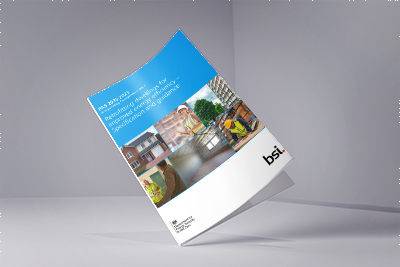PAS 2035:2023 in Practice – What the Updates Mean for Retrofit Professionals & Industry
As of 31st March 2025, PAS 2035:2023 became the required standard for all retrofit projects registered from that date onwards. Now that it’s been in use for a few months, it’s a good time to take another look at the differences between the new 2023 edition and the previous 2019 version.
Why was the standard updated?
Standards are regularly reviewed and updated to ensure they remain fit for purpose. This is especially important when government funding is tied to compliance, as is the case with PAS 2035. It’s essential that those working in the retrofit sector understand the changes and take the necessary steps to comply, helping to reduce the risk of funding issues further down the line.
As always, we strongly recommend reading the full document and using this summary to support your understanding. It’s important to read clauses in context rather than in isolation, as the document can be complex. Below, we’ve highlighted some of the key updates:
Key Process Changes
- The Risk Path procedure has been removed. As a result, changes have been made (such as to Retrofit Designer qualification requirements) based on the number of measures being installed and other relevant factors. (See later comments for more detail.)
- The definition of Traditional Construction has been updated and expanded (see page 5).
- A medium-term improvement plan is now required for all properties (clauses 5.3.1 and 8.1).
- The scope of the standard now includes distressed replacements of heating appliances (clause 7.2).
- Where appropriate, the Retrofit Assessor’s report must now cover additional issues that could impact the project in the short or long term (clause 7.3.2.I).
- The design criteria for airtightness and leakage strategy has been revised. If EEMs (Energy Efficiency Measures) improve the building fabric, a strategy must be included. If an airtightness target is set, a test must be carried out to prove compliance. However, setting a target is optional (clauses 8.2.35 and 8.2.36).
- If the Retrofit Designer identifies issues with the improvement option evaluation or the medium-term plan, these must be addressed and updated by the end of the design process (clause 8.2.38).
- The Retrofit Coordinator must collect evidence confirming that the installation of EEMs has been completed correctly. This can be done via in-person or remote/virtual site inspections, or by a third party if necessary. However, where any measure listed in clause 9.2 connects to or penetrates another fabric measure being installed (or already installed), an in-person inspection by the Coordinator is mandatory.
- A written record of all inspections must be kept, along with photographic evidence (clause 9.3.1).
- Guidance on retrofit at scale has also been updated (clause 5.4).
- PAS 2035 (2023) now includes a more detailed explanation with respects to significance assessments for building with aspects of significance, as well as a predefined survey checklist.
Updated Qualification Requirements
The qualification criteria for Retrofit Assessors and Retrofit Coordinators have been updated to align with the number-of-measures approach, although the core requirements remain unchanged. For Retrofit Designers, however, there has been a more notable change. The role can now only be undertaken by a suitably qualified Retrofit Designer, as defined in Annex A.3. This marks a shift from the previous version of the standard, where Retrofit Coordinators could act as Designers under Pathways A and B, however this is not the case under PAS 2035:2023.
Responsibility for design now firmly rests with the appropriately qualified Retrofit Designer, rather than the Coordinator.
In addition, the qualification requirements relating to the number of measures and projects involving traditionally constructed properties have been expanded, offering additional pathways and criteria to reflect the updated scope of the standard.
Revised Ventilation Standards
Ventilation has been updated in relation to the Building Regulations, introducing clauses as needed in Annex C where they are of a higher standard than the standards in force for the relevant devolved nations.
Specifically, where the package of specified and existing EEMs falls into Category B or C under Approved Document F, or there is evidence of condensation or mould, the adequacy of the existing ventilation must be examined, and the upgrades required as defined by which category the ventilation issues fall within.
What do the changes mean in practice?
The updates to PAS 2035 introduce new challenges, with changes such as the mandatory medium-term improvement plan, revised ventilation requirements, stricter site inspections and updated design responsibilities all adding to project costs. However, these changes are designed to raise standards across the board; improving the quality of installations, ensuring better outcomes for residents, and addressing long-standing issues seen in previous retrofit schemes. The aim is to deliver more energy-efficient, safer and healthier homes.
For professionals, it’s vital to understand the impact on roles and responsibilities. Assessors should consider upskilling with the Level 3 Old & Traditional Buildings qualification to ensure that work opportunities are not affected with respects to Traditional constructed properties. While Coordinators must now meet stricter criteria to undertake design work and may need to conduct on-site inspections to provide evidence of the work that has been completed.
Elmhurst continues to support its members by updating tools and templates to align with the new standard. TrustMark has also issued guidance to ease the transition, including clear deadlines: no PAS 2035:2019 assessments can be uploaded if the RdSAP inspection date or measure handover date is after 29th March 2025. Amendments to existing 2019 projects are still allowed, provided these deadlines are met.
Read the PAS 2035:2023 Standard in Full
For a full breakdown of all the changes and more an in-depth update, read the updated standard in full.
ACCESS PAS2035:2023
